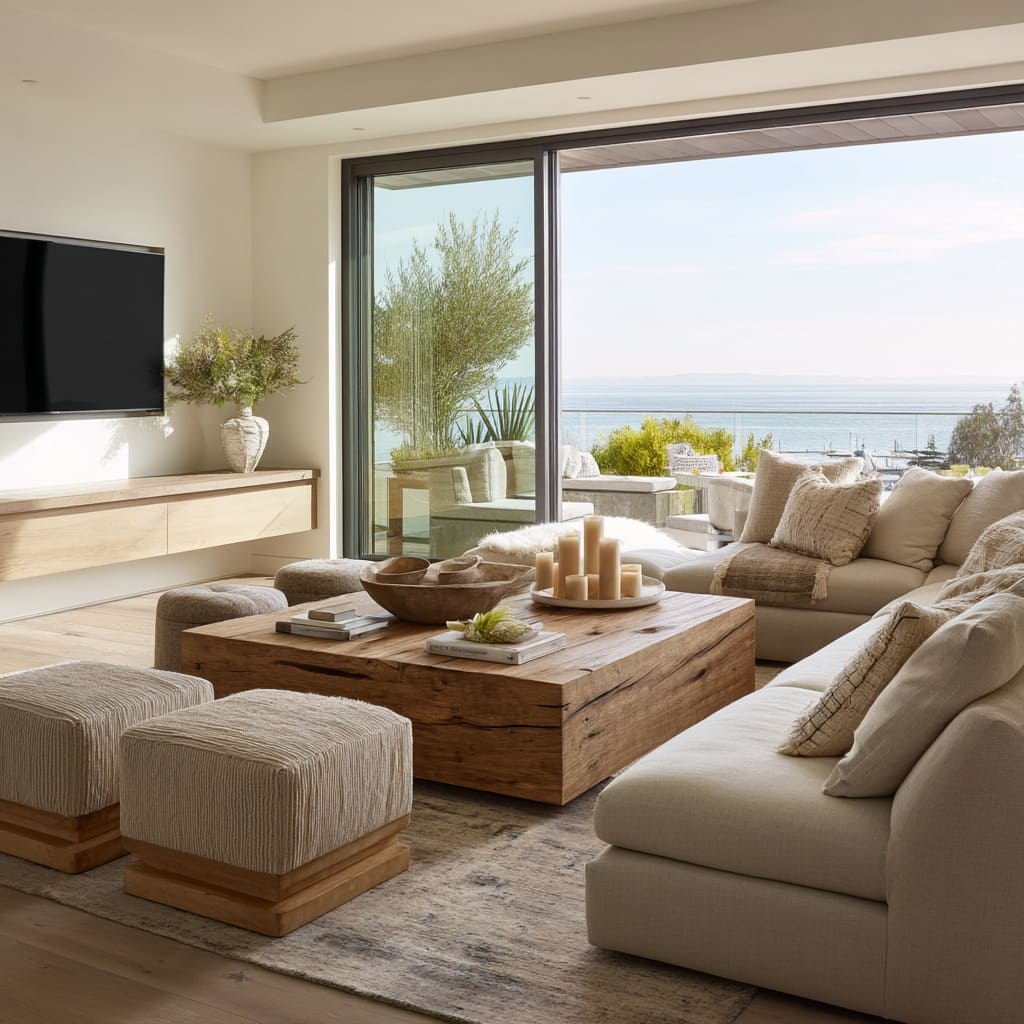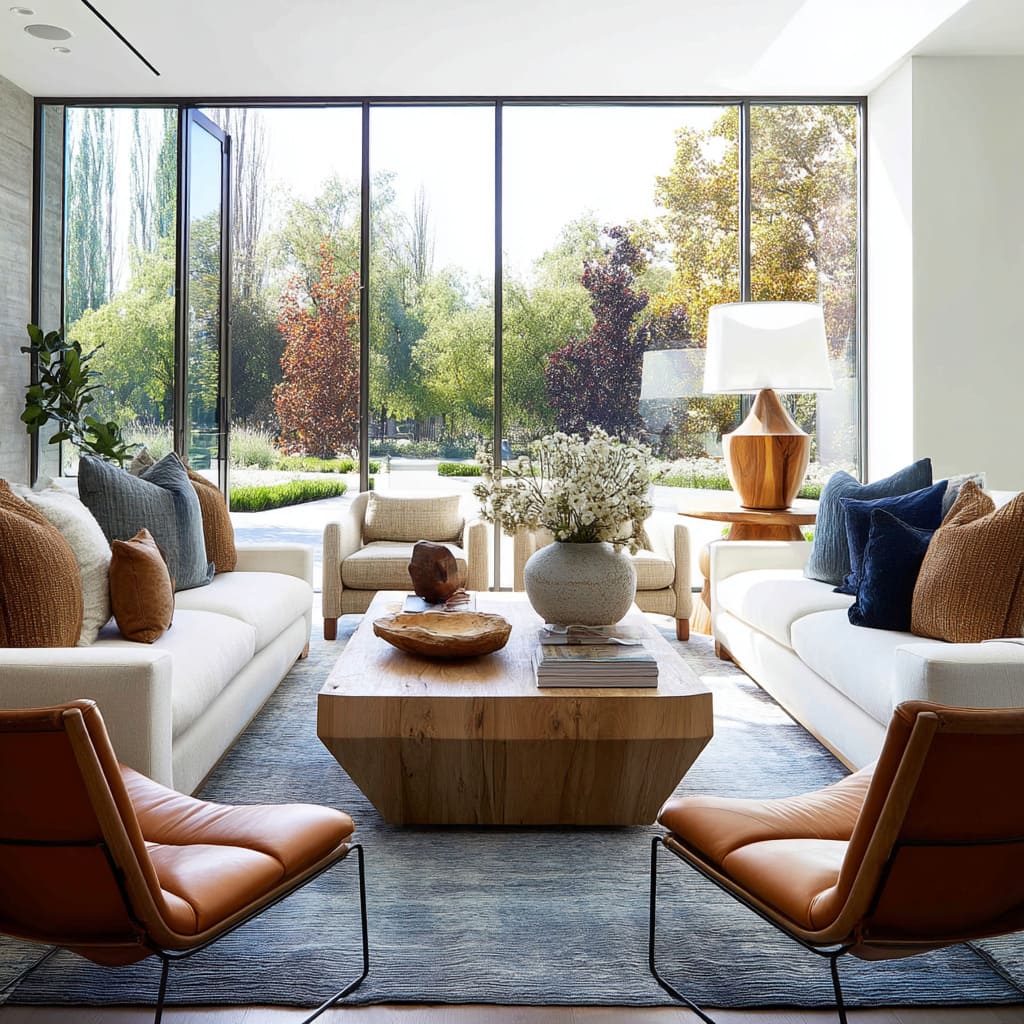
Today’s high-end living rooms are embracing a quieter form of sophistication—one that moves away from bold statements and toward spaces that feel grounded, curated, and deliberately understated. Whether nestled in a coastal retreat, a mountainside sanctuary, or a sleek urban high-rise, the aesthetic is shifting toward subtle elegance: think low-profile furnishings, sculptural coffee tables, and neutral palettes where texture becomes the primary storyteller.
The true transformation lies in the art of restraint. Designers are crafting environments through soft contrast—pairing raw stone with plush bouclé, setting matte surfaces against the faint shimmer of glass, and introducing greenery with the intention typically reserved for fine art.
Rather than relying on saturated color or ornate embellishment, these interiors are built on proportion, natural light, and timeless materials that speak for themselves. This piece explores the nuanced design principles quietly defining the most refined luxury living spaces today.
You’ll discover how volume, shadow, and even negative space shape the emotional tone of a room—often in ways that go unnoticed. These aren’t fleeting trends, but enduring design choices that operate with subtlety, elevating comfort and style from the background.
Architectural Elements:
Built-In Fireplace Accent Walls
In modern luxury living rooms, fireplaces are often designed to blend seamlessly with the surrounding wall, sometimes even appearing as part of the structure itself. Instead of adding extra artwork, designers focus on the wall’s finish—such as charred or layered wood, textured stone, or smooth plaster—to create a striking focal point.
This approach makes the fireplace both functional and visually captivating, with the natural qualities of the materials providing interest. Textured surfaces like charred wood or ridged stone change the way light plays across them during the day.
These subtle shifts prevent large walls from feeling flat and highlight the material’s unique texture, gently bringing warmth and life to the room.

Window Walls That Define and Enhance Interior Design
Expansive, thoughtfully framed glass walls invite nature to become a living work of art. Whether showcasing an urban garden or a vast coastal vista, these designs often emphasize large panes of glass without the distraction of heavy drapery or bold framing.
When the lines of indoor furnishings or vertical architectural elements mirror the shape or proportions of the window grid, a seamless harmony is created between the building’s structure and its interior. Repeated rectangles, clean outlines, and elongated forms work together to reinforce the geometry of the window design.
Seamless Blending of Indoor and Outdoor Spaces
Flooring, ceiling finishes, and fireplace materials often extend seamlessly onto decks and patios, blurring the boundaries between indoor and outdoor spaces. In many designs, using the same tile or wood outdoors creates the illusion of a larger living area that feels closely connected to the surrounding landscape.
Even when materials differ, coordinating colors or similar textures maintain a sense of visual harmony. For example, an interior stone hearth may be complemented by an outdoor concrete planter in matching tones—working together to expand the sense of space without fully opening the wall.

Shape and Proportion in Furniture Design:
Compact, Rectilinear Silhouettes

Modern luxury living rooms often feature sectional sofas and coffee tables characterized by boxy proportions and substantial, grounded bases. This design choice goes beyond comfort or a minimalist aesthetic—it serves as a deliberate visual strategy to “anchor” the seating area, creating balance against soaring ceilings and expansive windows.
These substantial furniture pieces provide a necessary counterweight to open, airy spaces. In rooms with double-height ceilings, the horizontal mass at floor level prevents the gaze from wandering upward without a defined focal point, ensuring the space feels both grounded and thoughtfully composed.
Multi-Level Layering of Elements

Coffee tables often showcase a collection of items arranged at different heights—stacks of books, a vase, or a shallow bowl. Similarly, side chairs and ottomans typically sit at slightly varying elevations compared to the main sofa.
These subtle differences in height break up uniformity and contribute to a thoughtfully curated, layered aesthetic.
Predominantly Neutral Color Schemes with Subtle Tone Variations

Contemporary luxury living rooms often embrace a palette of soft neutrals—whites, creams, and taupes—accented sparingly with rich, earthy tones like rust, charcoal, or navy. This combination creates a serene and understated atmosphere, while layering a variety of textures adds depth and interest.
Rather than relying on a single shade, subtle shifts among whites and beiges bring the space to life. Fabrics such as linen, boucle, and velvet in varying warm or cool tones introduce a nuanced richness, reflecting a keen sensitivity to how slight color variations are perceived in real life.
Blending Natural Materials and Soft Metallic Finishes
While not typically the centerpiece, subtle metallic accents—such as sculptural dishes, lamp bases, or sleek chair legs—introduce gentle glimmers to the space. These finishes are usually brushed or matte, ensuring they complement rather than overpower the soft, natural textures.
Designers tend to limit the use of reflective metals, prioritizing organic materials to maintain a serene atmosphere. When metal is present, it serves as a deliberate, understated detail that briefly catches the eye before fading into the overall calm of the design.

Harmonizing Plants with Indoor-Outdoor Living Spaces
Purposeful Plant Placement Beyond Decoration
From towering olive trees to broad-leafed tropical palms, greenery is chosen and positioned with care—typically near windows, corners, or transitional spaces. Designers create visual balance by pairing a large window or doorway with a tree of similar scale, achieving harmony without relying on perfect symmetry.
Often, indoor plants echo the shapes found outdoors; for example, an olive tree inside might align with olive trees in the garden beyond.
This “echo” technique connects indoor greenery to the surrounding landscape, fostering a seamless flow rather than simply filling empty spaces.
Dried Florals as Sculptural Texture
Instead of traditional fresh bouquets, many designers opt for dried grasses or branches. These elements introduce an organic texture, last longer without maintenance, and avoid the strong color contrasts that fresh flowers often bring.
With their muted tones and tactile quality, dried florals act more like subtle sculptures. Emphasis shifts from vibrant color to form and silhouette, allowing them to blend effortlessly with the room’s neutral palette while still adding visual interest.

Curated Illumination in Modern Living Spaces
Subtle, Integrated Lighting That Supports Architecture
In modern luxury living rooms, daylight remains the primary light source, while artificial lighting is deliberately understated. Overhead illumination typically comes from recessed fixtures—thin slots or low-profile can lights—that preserve the clean geometry of the ceiling.
Designers often align these recessed elements with window frames or architectural lines, signaling that lighting and ventilation were considered from the earliest design stages. This quiet integration of infrastructure avoids visual clutter and supports a streamlined, cohesive environment.
Sculptural Fixtures as Purposeful Accents
When visible lighting fixtures are used—such as a sculpted floor lamp or a slender pendant—they’re chosen with intention. Their form often reflects key furniture elements, like echoing the wood tone of a coffee table or the contour of an accent chair.
Larger fixtures are thoughtfully selected to align with the room’s architectural geometry or complement the organic curves of the seating arrangement. The result is harmony without distraction—no piece dominates unless deliberately meant to become a focal point.

Intentional Arrangements and the Power of Empty Space
Shelves, consoles, and coffee tables in modern luxury living rooms tend to showcase only a few carefully chosen pieces—perhaps a small stack of books, a hand-carved object, or a minimalist vase. These items are spaced deliberately, allowing visual breathing room and inviting the eye to pause.
Negative space is treated with as much importance as what fills it. The balance between objects and openness reflects thoughtful curation and restraint.
By avoiding overcrowding, designers allow architectural lines and material textures to remain the quiet focus of the room.

Artwork as a Natural Extension of the Space
In contemporary luxury interiors, artwork is often chosen for its ability to harmonize rather than dominate. Soft abstracts, tonal landscapes, and textural compositions frequently mirror the room’s palette or architectural rhythm. A muted seascape might reflect a nearby coastal view, while linear brushstrokes may echo the grain of wood-paneled walls or window mullions.
This subtle alignment—whether through color, form, or gesture—makes art feel seamlessly integrated. It enhances the surrounding architecture and mood without competing for attention, reinforcing the idea that every element belongs.

Strategic Depth with Rich Accent Tones
When deeper hues—such as navy, rust, or forest green—enter the room, they’re typically reserved for small-scale elements like cushions, an occasional chair, or the edge of a throw. This restrained use of color maintains the room’s lightness while adding a quiet sense of rhythm and visual grounding.
These richer tones act as intentional “anchor points,” drawing from architectural details like dark window frames or complementing the natural play of shadow across the space. The result is depth without disruption—color that supports, not overpowers.

Subtle Zoning Through Form and Material
In modern open-plan living rooms, physical dividers give way to softer, more intuitive cues. Low-profile sectionals, carefully placed chairs, and area rugs help define functional zones without interrupting the visual flow. Even a shift in flooring—from wood to stone, for example—can signal a transition from lounge to dining, without building a wall.
These quiet delineations maintain cohesion while supporting spatial clarity, making the room feel both expansive and intentionally organized—ideal for homes that favor seamless movement and flexible use.

Extending the Living Space Outdoors
Modern luxury interiors often blur the boundary between indoor comfort and outdoor retreat. By echoing the shapes, palettes, and materials of interior furnishings—such as low-slung sofas, neutral-toned cushions, or textural fabrics—designers create a visual rhythm that extends seamlessly onto patios or decks.
This repetition isn’t incidental. Matching or harmonizing finishes outdoors ensures the eye experiences the living area as one continuous zone, enhancing the sense of spaciousness and encouraging effortless flow between interior and exterior living.

Conclusion: Key Design Takeaways
- Material Integrity as Visual Anchor:
Architectural finishes—such as stone fireplace cladding, natural wood walls, or hand-troweled plaster—are treated as visual centerpieces. Rather than layering on excess decor, designers let materials with inherent character speak for themselves. - Softness Meets Structure:
Comfortable, low-slung seating in plush, neutral fabrics is thoughtfully paired with grounded forms—think sculptural stone tables or chunky wood bases. This balance delivers both visual weight and tactile contrast, offering a sense of relaxed sophistication. - Layered Neutrals Over Bold Color:
Warm whites, sandy taupes, and muted earthy tones dominate, but never feel flat—thanks to nuanced layering of textures like linen, boucle, wool, or brushed metals. The result is a calm, multi-dimensional palette that reads as quietly luxurious. - Greenery as Architectural Element:
Plants are not just decorative but compositional. Whether it’s an olive tree echoing an outdoor grove or dried grasses mimicking surrounding textures, greenery is placed with intention—aligned with windows, corners, and sightlines for maximum visual impact. - Uninterrupted Visual Flow:
Recessed lighting, flush-mounted vents, and slim-profile furnishings minimize clutter and keep attention on the space’s form, materials, and light. The absence of visual noise enhances clarity and calm. - Inside-Outside Material Continuity:
Designers increasingly continue flooring, stone, or wood finishes onto terraces and patios. This continuity of material creates spatial fluidity and strengthens the relationship between interior living and the surrounding landscape.
By harmonizing scale, proportion, and textural nuance, today’s luxury living rooms redefine elegance. They move away from overt display toward intentional restraint—where atmosphere, material honesty, and spatial rhythm create environments that feel both elevated and deeply livable. In these rooms, design isn’t loud—it resonates.

